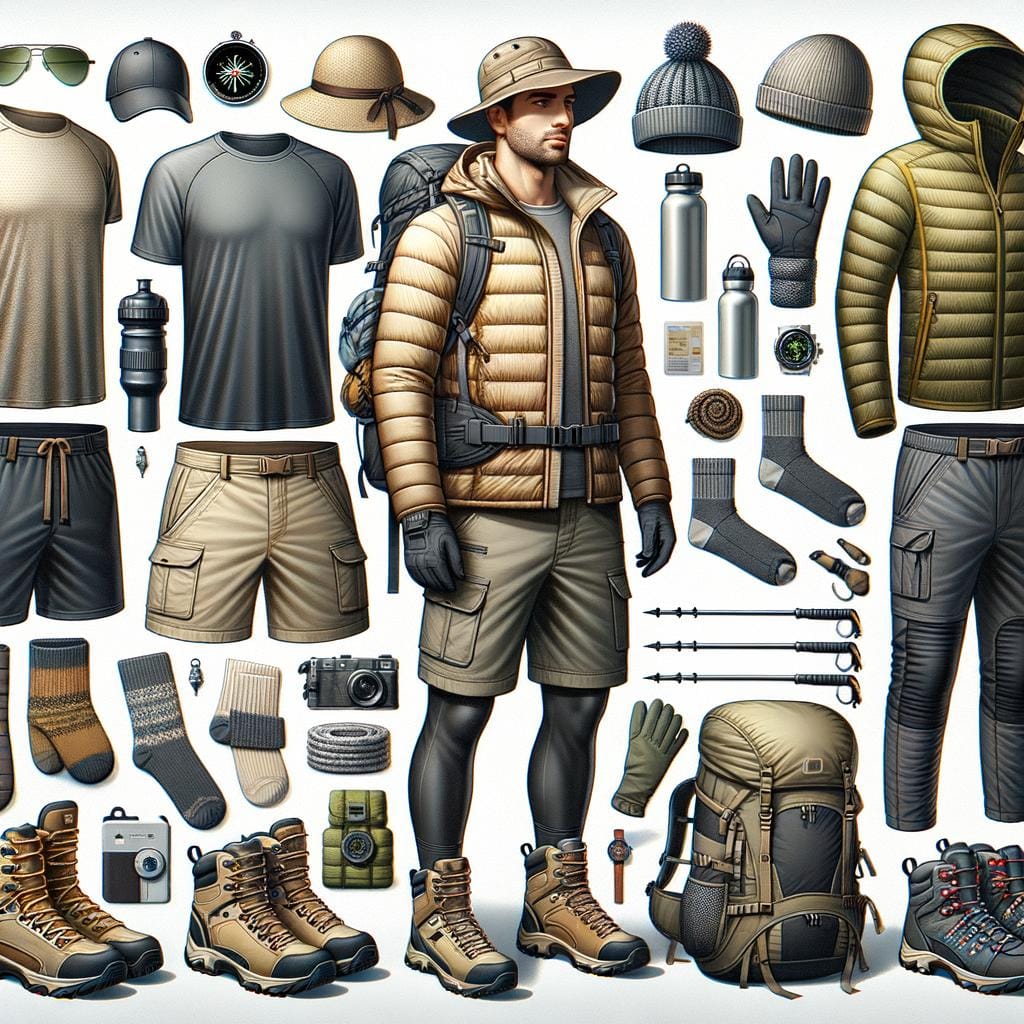Technical apparel has become a staple in the wardrobe of athletes, outdoor enthusiasts, and individuals looking for high-performance clothing. This specialized type of clothing is designed to enhance performance, provide comfort, and withstand the rigors of various activities. From hiking and running to cycling and skiing, technical apparel plays a crucial role in ensuring that individuals can push their limits while staying comfortable and protected.
The evolution of technical apparel dates back to its humble origins when athletes sought lightweight and breathable fabrics to enhance their performance. Over the years, advancements in technology and design have transformed technical apparel into a sophisticated blend of function and fashion. Today, technical apparel is not only about performance but also about style, making it a versatile choice for both active and casual wear.
One of the key reasons why technical apparel has gained widespread popularity is its numerous benefits. From moisture-wicking properties that keep you dry during intense workouts to temperature-regulating fabrics that adapt to changing conditions, technical apparel offers unmatched comfort and functionality. Additionally, the durability of technical apparel ensures that it can withstand repeated wear and tear, making it a long-term investment for anyone engaging in physical activities.
History of Technical Apparel
Technical apparel has a fascinating history that dates back to the early 20th century when outdoor enthusiasts began to demand more from their clothing in terms of performance and durability. In the early days, technical apparel was mainly used by mountaineers and explorers who needed specialized clothing to withstand harsh weather conditions. These early pieces of technical apparel were often made from natural materials such as wool and cotton, which had limitations in terms of moisture-wicking and insulation.
Advancements in Technical Apparel
As technology advanced, so did the materials used in technical apparel. In the 1970s and 1980s, synthetic fabrics like nylon and polyester were introduced, offering improved moisture-wicking properties and better durability. This marked a significant shift in the evolution of technical apparel, making it more accessible to a wider range of outdoor enthusiasts. Brands like Patagonia and The North Face emerged during this time, catering to the growing demand for high-performance outdoor clothing.
Modern-Day Technical Apparel
Today, technical apparel has become a staple in various activities ranging from hiking and skiing to running and cycling. With advancements in fabric technology, modern technical apparel now features innovative materials like Gore-Tex for waterproofing, merino wool for odor resistance, and breathable synthetic blends for enhanced comfort.
The evolution of technical apparel continues as brands strive to create garments that strike the perfect balance between function and style, making them ideal for both performance-driven athletes and casual outdoor enthusiasts alike.
Benefits of Technical Apparel
Technical apparel offers a multitude of benefits to individuals engaged in various activities, from outdoor enthusiasts to professional athletes. One significant advantage of technical apparel is its ability to enhance performance. The advanced fabrics used in technical garments are designed to wick away moisture, regulate body temperature, and provide enhanced breathability, allowing wearers to stay comfortable and focused during their activities. This can lead to improved endurance, better results, and overall satisfaction with the performance.
In terms of comfort, technical apparel excels in providing a lightweight and flexible fit that allows for unrestricted movement. Whether hiking through rough terrain or participating in high-intensity workouts, the ergonomic design of technical clothing ensures that users can move freely without any restrictions. Additionally, many technical apparel items feature seamless construction and anti-chafing properties, further enhancing the wearer’s comfort level during prolonged wear.
Furthermore, durability is a key characteristic of technical apparel that sets it apart from traditional clothing options. The innovative materials and construction techniques used in technical garments make them highly resistant to wear and tear, ensuring longevity even under challenging conditions.
This durability not only provides users with long-lasting performance but also adds value by reducing the need for frequent replacements. For those seeking reliable and robust clothing options for their active lifestyle, investing in quality technical apparel can prove to be a wise choice.
| Advantage | Description |
|---|---|
| Performance Enhancement | Moisture-wicking fabrics help regulate body temperature for improved focus. |
| Comfort | Ergonomic design for unrestricted movement and anti-chafing properties. |
| Durability | Innovative materials increase resistance to wear and tear for long-lasting use. |
Types of Technical Apparel
Technical apparel encompasses a wide range of clothing items designed to enhance performance and comfort during various activities. Within this category, there are different types of technical apparel tailored to specific needs and conditions. From base layers that regulate body temperature to outerwear that protects against the elements, as well as accessories that provide additional functionality, each type serves a unique purpose in optimizing performance.
Base Layers
Base layers are the foundation of technical apparel, designed to manage moisture and maintain optimal body temperature. Typically made from materials such as merino wool or synthetic fibers, these garments wick away sweat from the skin, keeping the wearer dry and comfortable. Base layers come in varying weights for different levels of insulation, making them suitable for a wide range of activities from high-intensity workouts to cold-weather adventures.
Outerwear
Outerwear in the realm of technical apparel is essential for protection against external elements such as wind, rain, snow, and cold temperatures. Whether it’s a waterproof shell for hiking in inclement weather or a insulated jacket for winter sports, technical outerwear is designed with specialized fabrics and features to keep the wearer warm, dry, and comfortable. This category also includes items like windbreakers, softshell jackets, and down coats, each catering to specific outdoor conditions.
Accessories
Accessories play a crucial role in enhancing the functionality and performance of technical apparel. From moisture-wicking socks that prevent blisters to gloves that provide dexterity without sacrificing warmth, accessories complement the overall outfit for maximum comfort and efficiency.
Other accessories include hats or beanies for head protection, buffs or neck gaiters for added warmth, as well as sunglasses or goggles for eye protection against UV rays or glare. The right accessories can make a significant difference in the overall experience while engaging in various activities wearing technical apparel.
Materials Used in Technical Apparel
Technical apparel is designed to enhance performance and comfort during various activities, making the choice of materials a crucial aspect of its construction. The innovative fabrics and technologies used in technical apparel play a significant role in ensuring that the garments meet the specific needs of athletes, outdoor enthusiasts, and individuals leading an active lifestyle. Understanding the materials used in technical apparel can help consumers make informed decisions when selecting products that best suit their requirements.
Some common materials found in technical apparel include moisture-wicking fabrics, such as polyester and nylon blends, which help to manage sweat and keep the wearer dry. These fabrics are particularly beneficial for high-intensity activities or outdoor sports where perspiration is a factor. Additionally, advancements in fabric technology have led to the development of antimicrobial properties that help control odor-causing bacteria, adding another layer of functionality to technical apparel.
When shopping for technical apparel, it is essential to consider the specific features of the materials used in each garment. To aid in this process, here are some key materials commonly found in technical apparel along with their benefits:
- Merino Wool: Known for its natural moisture-wicking properties and odor resistance.
- Gore-Tex: A waterproof and breathable membrane often used in outerwear for protection against harsh weather conditions.
- Elastane (Spandex): Provides stretch and flexibility for increased mobility during physical activity.
By understanding the materials used in technical apparel and their unique benefits, consumers can make informed choices that cater to their specific needs and activities. Whether it’s choosing a base layer with moisture-wicking properties or an outer shell with waterproof capabilities, the right combination of materials can enhance performance and comfort during any adventure.
How to Choose the Right Technical Apparel
When it comes to choosing the right technical apparel for your outdoor or sports activities, there are several factors to consider to ensure that you get the most out of your gear. One of the first things to take into account is the specific activity you will be engaging in.
Different technical apparel is designed with specific purposes in mind, whether it’s running, hiking, cycling, or skiing. Understanding the requirements of your activity will help you narrow down your options and focus on the features that are most important for your needs.
Another important factor to consider when choosing technical apparel is the fit. Technical apparel is often designed to be form-fitting or have specific tailoring to enhance performance and comfort. Make sure to try on different sizes and styles to find the one that offers a balance between freedom of movement and snugness.
Additionally, consider the layering system if you plan on wearing multiple pieces of technical apparel. Base layers should be close-fitting, while mid-layers can be looser for added insulation.
Furthermore, don’t forget about the weather conditions you will be facing during your activities. Technical apparel often comes with varying levels of insulation, breathability, and waterproofing to suit different climates and environments.
Be sure to check the specifications of each garment, especially when it comes to features like moisture-wicking properties, UPF sun protection, and ventilation systems. By taking these tips into consideration, you can make an informed decision when shopping for technical apparel that will enhance your performance and comfort during any outdoor pursuit.
| Factors | Considerations |
|---|---|
| Activity | Choose gear designed for your specific activity |
| Fit | Focus on finding a balance between comfort and performance in sizing |
| Weather Conditions | Select garments with appropriate insulation, breathability, and waterproofing |
Maintenance and Care of Technical Apparel
Technical apparel is designed to provide optimal performance, comfort, and durability during various activities, making it essential for individuals who lead an active lifestyle. To ensure that technical apparel maintains its high-quality features and functions effectively, proper maintenance and care are crucial. By following the right maintenance practices, users can prolong the lifespan of their technical apparel items and maximize their performance benefits.
When it comes to cleaning technical apparel, it is important to adhere to specific care instructions provided by the manufacturer. Most technical fabrics require gentle washing in cold water with mild detergent to prevent damage or shrinking.
Additionally, avoiding the use of fabric softeners or bleach is recommended as these harsh chemicals can deteriorate the fabric’s properties over time. Line drying or using a low heat setting on a dryer can help maintain the integrity of the technical apparel material.
Proper storage of technical apparel is equally important in preserving its quality and performance capabilities. It is advisable to hang or fold technical clothing items neatly in a cool, dry place away from direct sunlight or excessive heat. Storing technical apparel in a well-ventilated area will prevent moisture buildup, which can lead to odors and mold growth. Investing in breathable garment bags or storage containers designed for activewear can also help protect technical apparel from dust and environmental contaminants.
- Follow manufacturer’s care instructions
- Wash gently with mild detergent
- Avoid fabric softeners and bleach
- Line dry or use low heat settings
- Hang or fold neatly in a cool, dry place
- Away from direct sunlight or heat sources
- Store in well-ventilated areas to prevent moisture buildup
- Consider using breathable garment bags for storage
Conclusion
In conclusion, technical apparel plays a vital role in enhancing performance and comfort across various activities. From its humble beginnings to the innovative fabrics and technologies used today, technical apparel has evolved significantly to meet the needs of active individuals. The benefits of wearing technical apparel are vast, including improved performance, enhanced comfort, and increased durability. Whether it’s base layers, outerwear, or accessories, each category offers unique features to support an individual’s endeavors.
When choosing the right technical apparel, it is essential to consider factors such as fit, materials, and intended use. By selecting quality technical apparel that suits your specific activities and climate conditions, you can optimize your performance and stay comfortable throughout your adventures. Proper maintenance and care are also crucial in extending the lifespan of your technical apparel items. By following recommended cleaning procedures and storing them correctly, you can ensure that your gear continues to perform at its best.
In essence, investing in high-quality technical apparel is not just about style – it’s about functionality and performance. With the right gear tailored to your needs, you can push boundaries, explore new horizons, and conquer challenges with confidence. So next time you gear up for your favorite activity, remember the impact that technical apparel can have on your overall experience – because when you feel good in what you wear, you perform even better.
Frequently Asked Questions
What Is Technical Apparel?
Technical apparel refers to clothing designed with specific functionalities in mind, often incorporating advanced materials and construction techniques. These garments are engineered to enhance performance, provide protection, and improve comfort during physical activities.
What Is IT Tech Sportswear?
IT tech sportswear combines elements of information technology (IT) with athletic apparel, creating high-tech clothing that leverages data and connectivity for fitness tracking and performance optimization. These garments may include embedded sensors, smart fabrics, and integrated software to enhance the user’s sporting experience.
Why Is It Called Tech Pants?
Tech pants earn their name from their technological innovations and features designed to improve functionality and comfort. These pants often incorporate advanced materials like moisture-wicking fabrics, stretch panels for mobility, reinforced stitching for durability, and innovative pocket designs for convenient storage. The “tech” aspect highlights the garment’s focus on performance and utility in various activities.

An avid outdoor enthusiast, writer, and environmental advocate who has spent over two decades exploring the world’s most breathtaking landscapes. With a background in environmental science and a passion for adventure, Frances combines her love for nature with her talent for storytelling to inspire others to embark on their own outdoor journeys.



